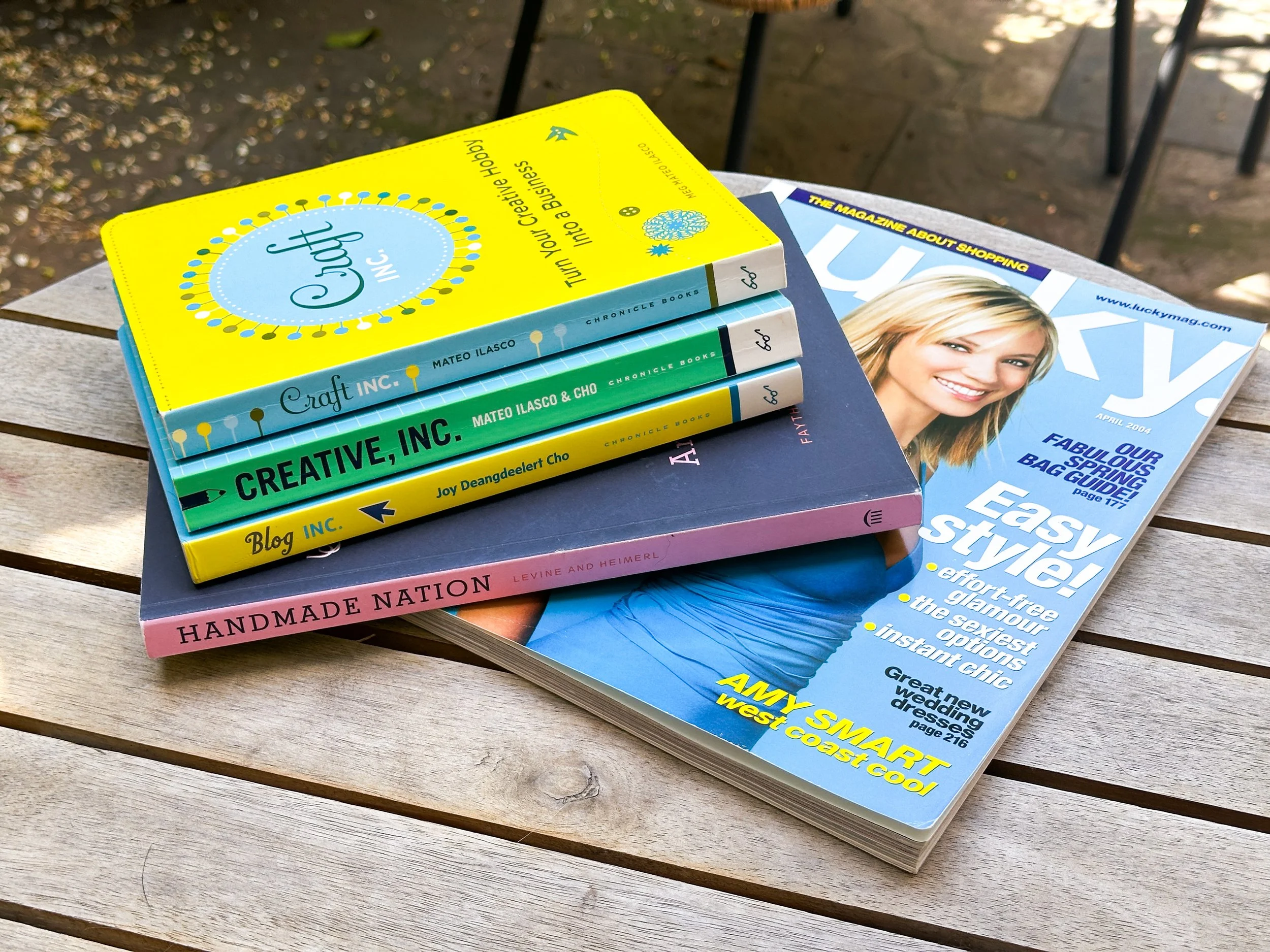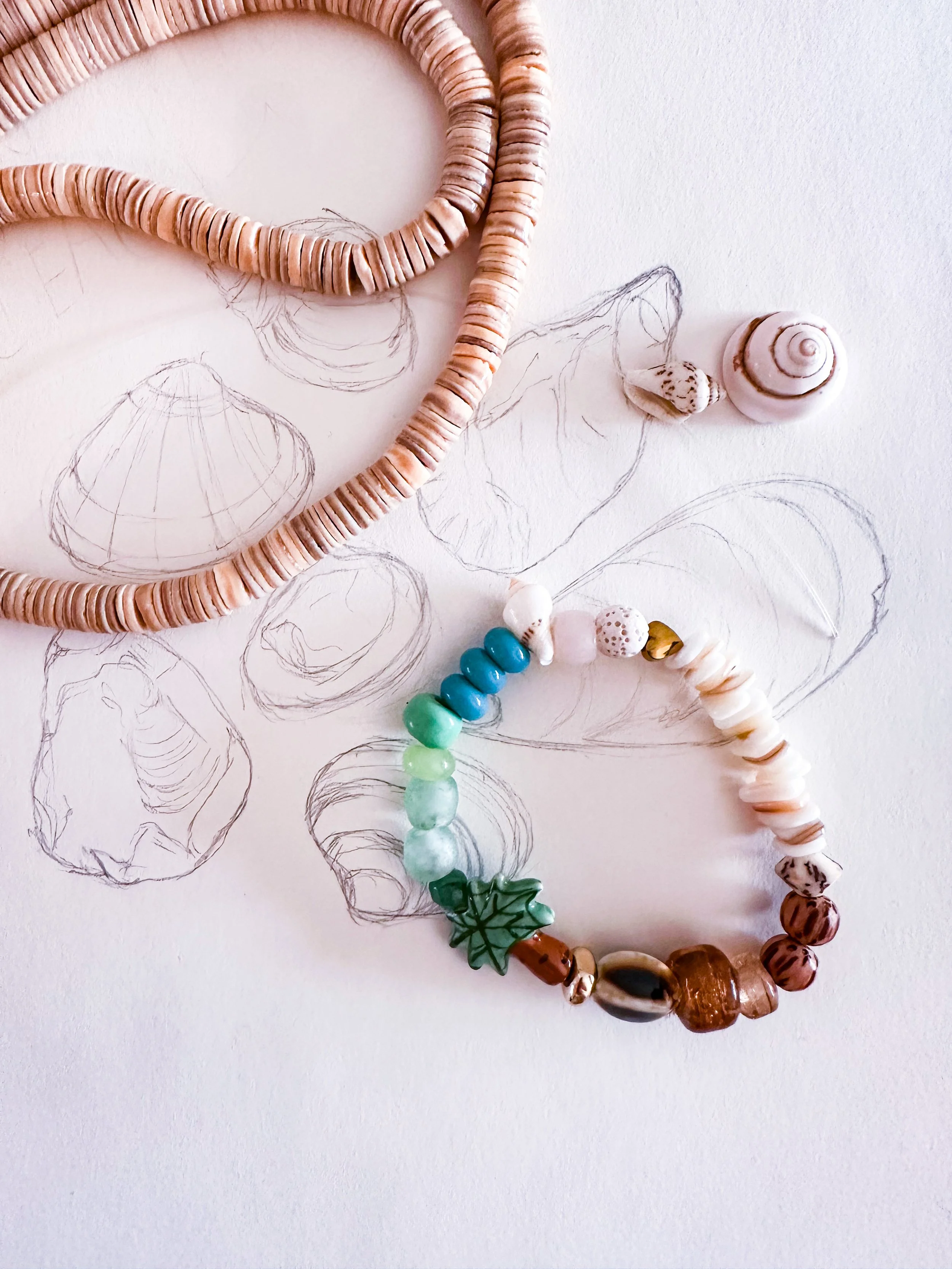Rage against the machine: the new analog movement
In the age of mass automation and capitalist burnout, maybe the next creative revolution is analog.
Back in 2007/2008, before algorithms ruled the internet and AI threatened to take over, the consumer market experienced what became known as the handmade or maker movement. Etsy entered the scene and gave a platform of shop ownership to makers and artists, indie craft fairs and makers markets were everywhere, and handmade communities formed both locally and online.
Artisans were stepping into the spotlight. And all of this wasn’t just about knitting, watercoloring, or letterpress. It was a reaction to the mass over-production and over-consumption of, quite frankly, disposable junk. A quiet revolt against mass production and the sameness of big-box retail. People craved things with fingerprints, quirks, stories, and a real human behind it.
Books from the first handmade movement-era, and a Lucky magazine (published from 2000 to 2015)
Around the same time, the Shop/Buy Local movement gained traction. Yet another reaction to globalization and corporate consolidation. Buying from your neighborhood store or independent maker became both an act of community building and economic resistance. “Small Business Saturday” emerged as backlash to “Black Friday” (though, somewhat ironically, SBS was created by corporate credit giant, American Express). These two movements — handmade and local — were rooted in the same belief: that where, how, and by whom something is made matters as much as what it is.
And as things go, history often repeats itself. This wasn’t the first revolt against industrial excess. A century earlier, the Arts and Crafts movement emerged in Britain and the U.S. as designers like William Morris rejected the dehumanizing effects of the factory age. Their answer wasn’t anti-progress; it was pro-human. They believed beauty and utility belonged together, that making things well was a moral act. As more than a century has passed, we’ve still seen industrial leaps met with a return to craft.
Fast forward to now. We’re about to hit a new saturation point in digital mass production.
AI can now paint, write, compose, and even “collaborate.” But the more machines create for us, the more we seem to crave the imperfect touch of a human hand. Call it the new rebellion: a quiet, analog uprising against endless automation. Feeds refresh faster than we can think. Everything is optimized for efficiency, not meaning. We’ve built a world that’s frictionless, perhaps, but also joyless, and a little bit empty.
It’s no surprise that creativity is migrating back toward texture and humanity: ink, paper, clay, film, fabric, vinyl. These mediums intertwine human thought and a tactile experience in the making and in the consuming.
| Then (2007–2010) | Now (2025) |
|---|---|
| Fast fashion → Slow fashion | Fast content → Slow creation |
| Mass production → Indie craft | Mass automation → Analog art |
| Desire for quality, story, ethics | Desire for authenticity, meaning, care |
| Human craft as resistance to industrial sameness | Human creativity as resistance to algorithmic sameness |
| Digital overload → Digital community return | Independent blogs, newsletters, message boards Fewer feeds, deeper connections |
This is what happens when late-stage capitalism meets mass automation: endless output, declining quality, and eroded connection. It’s the same logic that gave us fast fashion, now scaled to culture itself. Cheap, fast, disposable, bad for the environment.
We’ve been told more is always better. More speed, more efficiency, more scale, more, more, more. But what we’ve gained in output, we’ve lost in soul.
The first handmade and shop-local movements were about reclaiming quality and community from industrial production. This next one I believe is coming, is about reclaiming meaning from digital mass production.
Because artists, artisans, and craftspeople create better. They build slower. They make fewer things, but better ones. They create for community and expression, not solely for consumption. Their work naturally supports a circular economy: make it well, make it last, repair it, repurpose it. Buy from the person who made it, and your purchase becomes a relationship, not a transaction. That’s the opposite of fast fashion, where the true costs are hidden, the labor is distant, and the product is disposable by design.
Analog is back: a look at the data
- Vinyl: LP sales continue to grow year-over-year
- Print Magazines: Major titles relaunching in print fueled by Gen Z
- Books: Print continues to outperform e-books; specialty and small-press growth rising.
- Analog leisure: Board-game sales remain strong; instant-film cameras sales are up.
These are intentional choices driven by digital fatigue.
Sources: Deadline 2025 – Vinyl Sales and Music Revenue Trends | Asia News Network 2025 – Film and Instant Camera Comeback | PufferPrint 2024 – E-Books vs. Print Book Sales Comparison | Edition Cards 2024 – Board-Game and Analog Leisure Statistics | AFR - Physical magazines are making a comeback, with or without readers
When we choose art, craftsmanship, and locality, we reintroduce accountability. We know who made our clothes, our furniture, our ceramics, our meals. And when we know, we care.
And perhaps it doesn’t stop there. Maybe this analog impulse spreads wider: printed media, vinyl, DVDs instead of streaming services, physical books, puzzles, board games, even magazines. Was there anything better than a fresh stack of the new monthly issues and a cup of coffee on a Saturday morning? Bring it all back. Not as nostalgia, but as resistance, and proof that connection doesn’t need an algorithm.
The world doesn’t need more mass-produced junk: digital or otherwise. Even worse: it doesn’t need mass-produced junk that rips off legitimate artists in a fast-fashion, disposable cycle. It needs art. Real art, created by humans, emitting human emotions and communicating human statements. Artists, craftspeople, makers, and designers — the ceramicist, the jeweler, the woodworker, the embroiderer, the painter — the world needs people whose work carries evidence of time, skill, and judgment.
And digital media and art work belong here, too. Filmmakers, animators, illustrators using Procreate or Illustrator — they’re part of this same lineage. This is a defense of authorship, not a wholesale rejection of technology. The medium doesn’t matter as much as the creator and creative process.
Even further, “analog” in this sense doesn’t even have to mean interacting entirely offline. While we desperately need a revival of third places to build in-person community (and I believe we’ll start to see that as part of this movement as well), there’s a digital counterpart of community, too. A slow digital movement simmering beneath the surface as people tire of endless AI-produced slop and the performative “influencing.” Quiet rumblings of a return to independent blogs, personal newsletters, small online communities, and even bringing back message boards (but please, let’s leave the MySpace auto-play music and 5-minutes-to-load backgrounds squarely in 2007 where they belong). It’s the earlier days of the internet before social media rumbled through and turned into a massive advertising platform — back when you could truly connect with people with shared interests from all over the world.
What we really need here are digital spaces that value conversation over content, substance over scale. Places where algorithms don’t dictate what we see or who we are. It’s the same impulse as the analog revival: fewer things, deeper meaning, slower scrolling.
AI can generate, but it can’t care. It can’t build lineage or legacy. It can’t fix what capitalism broke, and it only adds to the idea that things, and people, are disposable.
To be clear, I’m not anti-AI, and this isn’t a “get off my lawn” rant. And digital isn’t the villain. It democratized access, removed barriers, and connected creative communities that would’ve never met. The danger is mistaking access for experience. The analog shift is a recalibration of a pendulum swinging in the wrong direction.
I believe AI, when used thoughtfully, can augment human capability. It can help us brainstorm, edit, analyze, synthesize, prototype, or visualize faster. But there’s a difference between using AI to expand creative range and explore possibilities, and using it to replace creativity and thinking altogether. The former makes us better; the latter makes us irrelevant. The danger isn’t the tool itself, but rather the temptation to let automation strip away the human touch that gives work its soul and its legacy.
Design, at its best, has always been the bridge between art and production. And I’ve said before: Design is a superpower. Not because it scales output, but because it shapes systems. Systems need human intelligence to stay humane.
A few of my own contributions to the handmade movement
If the 2007 movement resisted mass production, this one resists mass automation. If Etsy once stood for indie authenticity, its current state, flooded with drop-shipped knockoffs and AI “designs,” shows exactly why this next wave matters. For leaders, this doesn’t stop at a cultural movement. For them, it’s strategic leverage. People fed up with capitalism’s churn want work and products that mean something, not just things that scale at the expense of humans.
It’s my deepest hope that the brands and companies that win the next decade and beyond are the ones that slow down, and that value quality, craft, and transparency over algorithmic efficiency. Will they integrate AI into the processes? Of course. But I hope they don’t lose their humanity in the process.
Maybe this is our new rage against the machine. It’s not loud and destructive, but instead filled with intent and beautifully — exceptionally, uniquely — human. A new revolution led by artists, designers, and craftspeople who refuse to disappear into automation.
Because the abundance of AI will only make human creativity, and human care, more valuable. So the question becomes: what will you make that only you can?
A note from me:
I first explored these cultural ideas in my MFA in Fashion, studying in real time how the slow fashion and craft movements rose in response to fast production and capitalist excess, and I focused my thesis work on independent artisans. Nearly two decades later, we’re seeing the same pattern again, only now the factory is digital. Last year I completed a certificate in AI for Creativity and Leadership where I explored these concepts and ideas further. I remain interested and engaged in art, handmade design, sustainability, and the circular economy.
Whether it’s art, craft, or artisan work, the value isn’t just in the finished product. It’s in the judgment, the choices, and the stories embedded in the making. AI can churn out a lot of things, but it can’t be original. It can’t be an artist. It can’t be a craftsperson. That’s why this next movement matters.


